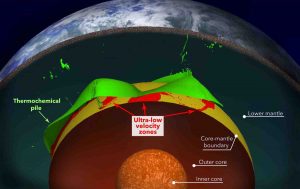
A team led by geoscientists from Arizona State University and Michigan State University has used computer modeling to explain how pockets of mushy rock accumulate at the boundary between Earth’s core and mantle.
These pockets, lying roughly 2,900 kilometers (1,800 miles) below the surface, have been known for many years, but previously lacked an explanation of how they formed.
The relatively small rock bodies are termed “ultra-low velocity zones” because seismic waves greatly slow down as they pass through them. Geoscientists have thought the zones are partially molten, yet the pockets are puzzling because many are observed in cooler regions of the deep mantle.
“These small regions have been assumed to be a partially molten version of the rock that surrounds them,” says Mingming Li, lead author of the study, which was published August 2, 2017, in the journal Nature Communications. “But their global distribution and large variations of density, shape, and size suggest that they have a composition different from the mantle.”
Li joined ASU’s School of Earth and Space Exploration (SESE) this month as an assistant professor. He was a graduate student of former SESE associate professor Allen McNamara, also a coauthor on the paper; McNamara is now at Michigan State’s Department of Earth and Environmental Sciences. The additional coauthors are SESE professor Edward Garnero and his PhD student Shule Yu.
“We don’t know what ultra-low velocity zones are,” says McNamara. “They are either hot, partially-molten portions of otherwise normal mantle, or they are something else entirely, some other composition.”
Because seismic evidence allows both possibilities, he says, “We decided to model mantle convection by computer to investigate whether their shapes and positions can answer the question.”
Do pockets relate to blobs?
About year ago, Garnero, McNamara, and SESE associate professor Dan Shim reported that two gigantic structures of rock deep in the Earth are likely made of something different from the rest of the mantle. They called the large structures “thermochemical piles,” or more simply, blobs.
“While the origin and composition of these blobs are unknown,” Garnero said at the time, “we suspect they hold important clues as to how the Earth was formed and how it works today.”
What the big blobs are made of and how they formed still remain unknown, says Garnero. “But the new computer modeling explains how these ultra-low velocity zones are associated with the much bigger blobs.”
Li says, “The ultra-low velocity zones are generally around tens of kilometers tall, and hundreds of kilometers wide or less. They are mostly located near the edges of the much larger blobs, but some of them are detected both inside the blobs and well away from them.”
The outcome of the computer modeling showed that most of these ultra-low velocity zones are different in composition from the surrounding mantle, Li says. What’s more, the modeling showed that pockets of rock with different compositions will migrate from anywhere on the core-mantle boundary towards the margins of the large blobs.
“The margins of the thermochemical piles are where mantle flow patterns converge,” McNamara says, “and therefore these areas provide a ‘collection depot’ for denser types of rock.”
Gathered by heat
The force driving this movement is heat, which powers convection in the mantle.
Earth’s mantle is made of hot rock, but it behaves more like fudge simmering slowly on a stove. In the mantle, heat comes both from radioactivity within the mantle rock and from the planet’s core, the center of which is about as hot as Sun’s surface. Mantle rock responds to this heat with a slow churning—convective—motion.
“The details are not completely clear,” says Li. But the modeling shows that rocks of different composition respond to the convection in a way that gathers compositionally similar materials together. This moves the small pockets of chemically distinct rocks to the edges of the hotter blobs above the core-mantle boundary.
“We ran 3D high-resolution computer modeling and we developed a method to track the movement of both the small pockets of ultra-low velocity zones and the much larger thermochemical piles.” Li explains, “This allowed us to study how the small pockets move around and how their locations can be related to their origin.”
McNamara says, “What was new about our approach—and also computationally challenging—was that the modeling simultaneously took into account vastly different scales of motion.” These ranged from global mantle-scale convection patterns, to the large thermochemical piles in the lower mantle, and down to the very small-scale pockets of ultra-low velocity zone at the bottom.
“What we ultimately found,” he says, “is that if ultra-low velocity zones are caused by melting of otherwise normal mantle, they should be located well inside of the thermochemical piles, where mantle temperatures are the hottest.”
But he adds, “If the ultra-low velocity pockets of rock have a composition different from the ordinary mantle rock, then mantle convection would continually carry them to the edges of piles where they collect.
“This is consistent with what we see in the seismic observations.”
Rocks diving deep?
Where do the different materials in the deep mantle come from in the first place?
“There are several possibilities,” Garnero says. “Some material might be associated with former basaltic oceanic crust that got subducted deeply. Or it might be associated with chemical reactions between the outer core’s iron-rich fluid and the crystalline silicate mantle.”
Garnero says that where the rock in ultra-low velocity zones originally came from is currently unsolved. But the process of collecting this material into small pockets of rock is clear.
“You can have various mechanisms, such as plate tectonics, that push rock of differing chemistries into the deepest mantle anywhere on Earth,” he says.
“But once these different rocks have gone down deep, convection wins and sweeps them to the hot regions, namely, where the continental-sized thermochemical piles reside.”
Reference:
Mingming Li et al, Compositionally-distinct ultra-low velocity zones on Earth’s core-mantle boundary, Nature Communications (2017). DOI: 10.1038/s41467-017-00219-x
Note: The above post is reprinted from materials provided by Michigan State University.










